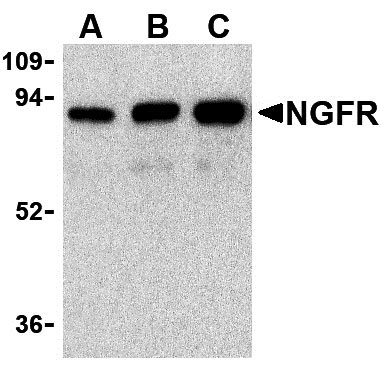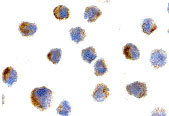NGFR Antibody
- 产品详情
- 实验流程
- 背景知识
Application
| WB, ICC, E |
|---|---|
| Primary Accession | P08138 |
| Other Accession | NP_002498, 4505393 |
| Reactivity | Human, Mouse |
| Host | Rabbit |
| Clonality | Polyclonal |
| Isotype | IgG |
| Calculated MW | 45183 Da |
| Concentration (mg/ml) | 1 mg/mL |
| Conjugate | Unconjugated |
| Application Notes | NGFR antibody can be used for the detection of NGFR by Western blot at 1 µg/mL. Antibody can also be used for immunocytochemistry starting at 10 µg/mL. |
| Gene ID | 4804 |
|---|---|
| Other Names | NGFR Antibody: CD271, p75NTR, TNFRSF16, p75(NTR), Gp80-LNGFR, Tumor necrosis factor receptor superfamily member 16, NGF receptor, nerve growth factor receptor (TNFR superfamily, member 16) |
| Target/Specificity | NGFR; |
| Reconstitution & Storage | NGFR antibody can be stored at 4℃ for three months and -20℃, stable for up to one year. As with all antibodies care should be taken to avoid repeated freeze thaw cycles. Antibodies should not be exposed to prolonged high temperatures. |
| Precautions | NGFR Antibody is for research use only and not for use in diagnostic or therapeutic procedures. |
| Name | NGFR |
|---|---|
| Synonyms | TNFRSF16 |
| Function | Low affinity receptor which can bind to NGF, BDNF, NTF3, and NTF4. Forms a heterodimeric receptor with SORCS2 that binds the precursor forms of NGF, BDNF and NTF3 with high affinity, and has much lower affinity for mature NGF and BDNF (PubMed:24908487). Plays an important role in differentiation and survival of specific neuronal populations during development (By similarity). Can mediate cell survival as well as cell death of neural cells. Plays a role in the inactivation of RHOA (PubMed:26646181). Plays a role in the regulation of the translocation of GLUT4 to the cell surface in adipocytes and skeletal muscle cells in response to insulin, probably by regulating RAB31 activity, and thereby contributes to the regulation of insulin- dependent glucose uptake (By similarity). Necessary for the circadian oscillation of the clock genes BMAL1, PER1, PER2 and NR1D1 in the suprachiasmatic nucleus (SCmgetaN) of the brain and in liver and of the genes involved in glucose and lipid metabolism in the liver (PubMed:23785138). Together with BFAR negatively regulates NF-kappa-B and JNK-related signaling pathways (PubMed:22566094). |
| Cellular Location | Cell membrane; Single-pass type I membrane protein. Cytoplasm. Perikaryon {ECO:0000250|UniProtKB:Q9Z0W1}. Cell projection, growth cone {ECO:0000250|UniProtKB:Q9Z0W1}. Cell projection, dendritic spine {ECO:0000250|UniProtKB:Q9Z0W1} |
For Research Use Only. Not For Use In Diagnostic Procedures.
Provided below are standard protocols that you may find useful for product applications.
BACKGROUND
NGFR Antibody: The tumor necrosis factor (TNF) and TNF receptor (TNFR) gene superfamilies regulate numerous biological functions including cell proliferation, differentiation, and survival through regulating the activation of the transcription factor NF-κB and various mitogen-activated protein kinases. Nerve growth factor receptor (NGFR) was one of the earliest characterized members of this family. Also known as the low-affinity receptor p75NTR, this receptor is involved in several diverse functions such as apoptosis, neurite outgrowth during development, and myelination. Its ligands include NGF, brain-derived neurotrophic factor (BDNF), NT3, and NT4. NGFR can also associate with other NGF receptors such as Trk through the cytosolic and transmembrane domains and thus can function as a co-receptor that refines Trk affinity and specificity for neurotrophins. Finally, upon binding of various neurotrophins, NGFR associates with tumor necrosis factor receptor-6 (TRAF6), suggesting that it can potentially function as a signal transducer for NGF signals through NGFR.
REFERENCES
Gaur U, Aggarwal BB. Regulation of proliferation, survival and apoptosis by members of the TNF superfamily. Biochem. Pharmacol. 2003; 66:1403-8.
Johnson D, Lanahon A, Buck CR, et al. Expression and structure of the human NGF receptor. Cell 1986; 47:545-54.
Gentry JJ, Barker, PA, and Carter BD. The p75 neuro-trophin receptor: multiple interactors and numerous functions. Prog. Brain Res. 2004;146:25-39.
Nykjaer A, Willnow TE, and Petersen CM. p75NTR - live or let die. Curr. Opin. Neurobio. 2005; 15:49-57.
终于等到您。ABCEPTA(百远生物)抗体产品。
点击下方“我要评价 ”按钮提交您的反馈信息,您的反馈和评价是我们最宝贵的财富之一,
我们将在1-3个工作日内处理您的反馈信息。
如有疑问,联系:0512-88856768 tech-china@abcepta.com.























 癌症的基本特征包括细胞增殖、血管生成、迁移、凋亡逃避机制和细胞永生等。找到癌症发生过程中这些通路的关键标记物和对应的抗体用于检测至关重要。
癌症的基本特征包括细胞增殖、血管生成、迁移、凋亡逃避机制和细胞永生等。找到癌症发生过程中这些通路的关键标记物和对应的抗体用于检测至关重要。 为您推荐一个泛素化位点预测神器——泛素化分析工具,可以为您的蛋白的泛素化位点作出预测和评分。
为您推荐一个泛素化位点预测神器——泛素化分析工具,可以为您的蛋白的泛素化位点作出预测和评分。 细胞自噬受体图形绘图工具为你的蛋白的细胞受体结合位点作出预测和评分,识别结合到自噬通路中的蛋白是非常重要的,便于让我们理解自噬在正常生理、病理过程中的作用,如发育、细胞分化、神经退化性疾病、压力条件下、感染和癌症。
细胞自噬受体图形绘图工具为你的蛋白的细胞受体结合位点作出预测和评分,识别结合到自噬通路中的蛋白是非常重要的,便于让我们理解自噬在正常生理、病理过程中的作用,如发育、细胞分化、神经退化性疾病、压力条件下、感染和癌症。







